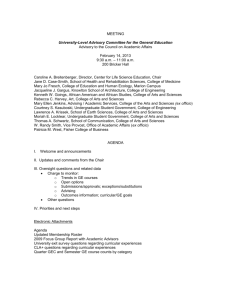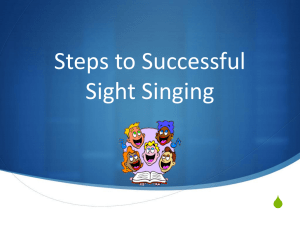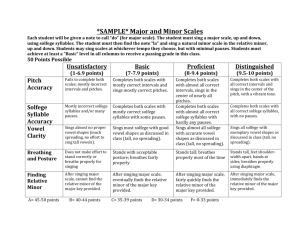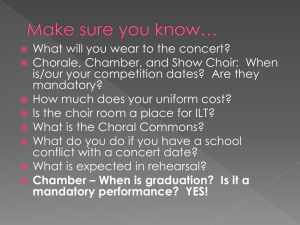Objective
advertisement
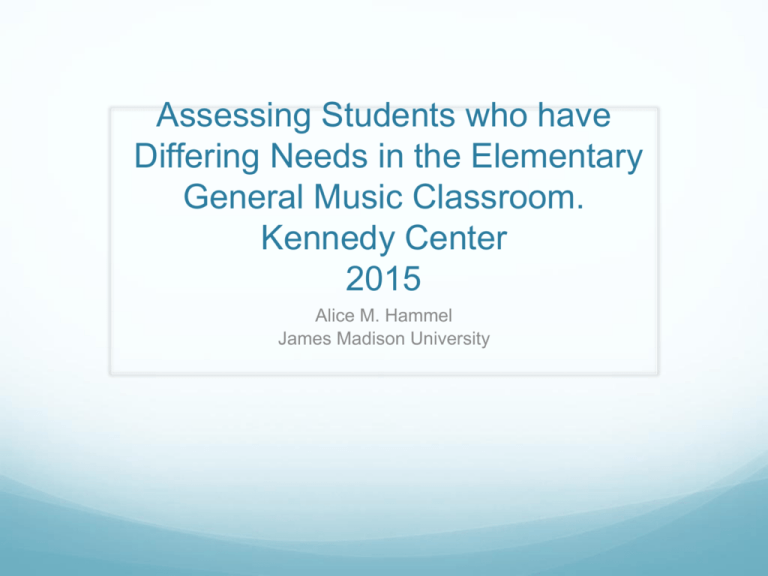
Assessing Students who have Differing Needs in the Elementary General Music Classroom. Kennedy Center 2015 Alice M. Hammel James Madison University How is my child doing in music? We often provide behavioral or general information to that question. Individualized feedback through multiple strands of learning is sometimes difficult when we have hundreds of young students to teach. Students who need individualized learning Some students are months or years behind others in their general music class Other students are months or years ahead of others in their general music class The benefits of winding instruction Winding back Winding forward Multiple means and access points Adaptations and Accommodations Size Color Pacing Modality Modifications Winding forward or backward to find the specific step within a sequence that meets the current need of the student. Assessing students where they are in the sequence, rather than at the central objective or goal for the majority of the students. Finding the place within the sequence Sometimes on an incremental level May be different and dependent upon the specific day or student profile Sensory Behavioral Cognitive Communication Physical Modifying in the Classroom Winding back Winding forward Keeping all plates spinning Elementary Rhythm Sequence Often includes quarter, paired eighth, sixteenth notes, and equivalent rests. How do we and how have you used? Size Color Pacing Modality Rhythm Activities Bate Bate Rhythm Ladder Rhythm Go Round Rhythm Flash Cards (fly swatter) Find Your Family Bee Bee Bumblebee (popsicle differentiation) Rhythm Rondo Elementary School Rhythm Reading Sequence Chart Melody Activities Doggie Doggie Tone Ladder Beach Ball Melody Flashcards (fly swatter) Tone Set Finger Staff Sol Mi Duke’s Place First Grade Melodic Sequence Non-modified or adapted curricular goals Students will decode quarter eighth patterns from chants that are well-known to them Modified curricular goals Adapted curricular goals Student will tap the rhythm with words to chants that are wellknown to him Student will derive quarter eighth patterns using popsicle sticks given as much time as necessary First Grade Melodic Sequence Non-modified or adapted curricular goals Students will apply new rhythm syllables to chants well-known to them Modified curricular goals Adapted curricular goals Student will chant rhythms that contain quarter/eighth with other students Student will chant using rhythm syllables at a tempo of his choosing First Grade Melodic Sequence Non-modified or adapted curricular goals Students will sing sol-mi patterns using neutral syllables Modified curricular goals Adapted curricular goals Student will approximate higher and lower pitches following individual prompt by teachers Student will sing sol-mi patterns using neutral syllables at a tempo of his choosing First Grade Melodic Sequence Non-modified or adapted curricular goals Students will show higher and lower with their hands and with the use of icons Modified curricular goals Adapted curricular goals Student will show higher and lower through any modality he prefers Student will demonstrate higher and lower using icons and/or body motions First Grade Melodic Sequence Non-modified or adapted curricular goals Students will discover the two pitches (sol and mi) and their similarities as noted in several folk songs wellknown to them Modified curricular goals Adapted curricular goals Students will sing folk songs that contain sol-mi with other students Student will discover sol-mi in at least one folk song well-known to him First Grade Melodic Sequence Non-modified or Modified adapted curricular goals curricular goals Students will apply new solfege syllables to chants well-known to them Adapted curricular goals Student will apply new solfege syllables to at least one chant well-known to him Later melodic sequence ideas Let us Chase the Squirrel Great Big House in New Orleans Tracking progress through time Student name Sings a variety of do pentatonic songs Sings a variety of do pentatonic songs in solfege Reads a variety of do pentatonic songs in solfege, from various staff placements X Jonathon X X Maribeth X X X Isaiah X X X Anibel X X Quin X Tanner X X X Hsui-Hui X X X Decodes solfege of known songs and patterns that include do, re, mi, sol, and la X Uses solfege (do, re, mi, sol, and la) abstractly, in tone ladders and tone sets X X Activities to prepare various tonal centers Y Toop D’rom Now All the Woods are Waking Ah Poor Bird (bum) Identification of Scale Type Steps to identifying scale type Sing a variety of songs and name them as a known scale type or “other”. Sing the resting tone. Sing a selected song in the new scale type with text. Sing the song in solfege. Sing and identify the resting tone in solfege. Sing and list all the pitches used in the song as a tone set; the teacher writes the pitches from lowest to highest, leaving a space for any missing solfege. Circle the resting tone in the tone set. Count the number of different solfege pitches used. Name the scale, with resting tone first, then the number of different solfege pitches (bi = 2 pitches, tri = 3 pitches, tetra = 4 pitches, penta = 5 pitches, hexa = 6 pitches). Tonic scales do not include fa; chordal scales include fa. Date of mastery Activities to encourage part singing Skip to my Lou Now All the Woods are Waking Ah Poor Bird Jubilate Deo Part Singing Curricular goal Student sings the text in a large group while the teacher sings the resting tone as a pulse with text. Student sings the resting tone as a pulse with text in a large group while the teacher sings the text. Student sings the text in a small group while the teacher sings the resting tone as a pulse with text. Student sings the resting tone as a pulse with text in a small group while the teacher sings the text. Student sings the resting tone as a pulse in solo with text while another student sings the text. Student sings the text while another student sings the resting tone as a pulse with text. Date of mastery Part work activities Chants My Mother, Your Mother Bee Bee Bumble Bee/Bate Bate Songs Hot Cross Buns/Lucy Locket Let us Chase the Squirrel/Great Big House Part singing progress through time Activity (i.e. canon, rhythmic ostinato or partner songs) Jonah Becca Simon Jaidyn Sings song without help Sings the song while another part occurs (i.e. ostinato, drone, canon) Describes and identifies the other part Performs the other part Performs the other part while the song occurs Performs the song and the other part simultaneously (i.e. tapping/playing the ostinato, hand signing in canon) Charting Student Learning Objectives Objective: The students will solfege unfamiliar patterns using only notes in the diatonic major scale (steps-no skips), and rhythms that include quarter, paired eighth, and half notes, and equivalent rests. Pitch Matching Steps Pitch Matching Sing major scale on neutral syllables, ascending ☐ Sing major scale on neutral syllables, descending ☐ Sing major scale with solfege, ascending Sing major scale with solfege, descending ☐ Sing pitches on a staff with solfege Find and sing “do” using a ☐ ☐ ☐ Reading Steps Reading Recognize staff ☐ Recognize treble and bass clefs ☐ Understand line and space notes ☐ Name the line in both clefs ☐ Name the space in both clefs ☐ Identify notes on lines and spaces in both clefs ☐ Recognize rhythms: half, quarter, eighth, and equivalent rests ☐ Recognize bar lines and measures ☐ Recognize time signatures 2/4, 3/4 and 4/4 ☐ Rhythm Readiness Steps Rhythm Readiness Maintain steady beat ☐ Chant and clap ☐ Perform half notes and rests ☐ Perform quarter notes and rests ☐ Perform paired eighth notes ☐ Honoring the Individual Pacing during class Time outside of class Materials and music that fit developmental needs Placing the students at the center of everything you do at school The Fable

